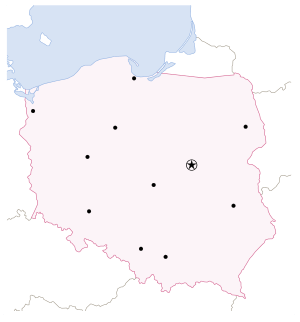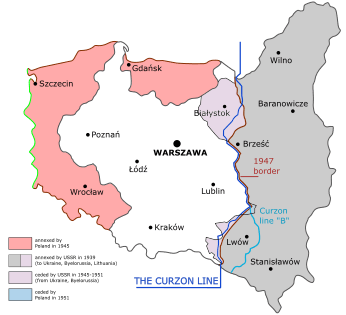Borders of Poland
The Borders of Poland are 3511[1] or 3582 kilometers long.[2] The neighboring countries are Germany to the west, the Czech Republic and Slovakia to the south, Ukraine and Belarus to the east, and Lithuania and the Russian province of Kaliningrad Oblast to the northeast. To the north, Poland is bordered by the Baltic Sea.




Breakdown of border lengths per entity:
- Czech Republic–Poland border: 796km[1] or 790km[2]
- Poland–Slovakia border: 541km[1] or 539km[2]
- Poland–Ukraine border: 535km[1] or 529km[2]
- Germany–Poland border: 467km[2][1]
- Belarus–Poland border: 418km[1] or 416km[2]
- Poland–Russia border (Kaliningrad Oblast): 210km[2][1]
- Lithuania–Poland border: 104km[1] or 103km[2]
- sea (Baltic Sea): 440km[1] or 528km[2]
The Polish coastline is 770km long.[1]
History
The borders of modern Poland were defined in the aftermath of the Second World War and the establishment of the People's Republic of Poland. They were agreed in the field of international law by the Yalta Agreement of February 11, 1945 and the Potsdam Agreement of August 2, 1945. These agreements generally defined the course of borders, without setting them out in detail. Their specification and then demarcation in the field had to be normalized in bilateral agreements between the states concerned.
Major border crossings
After accession of Poland to the European Union in 2004, border crossings with EU states (Germany, Czech Republic, Slovakia and Lithuania) were made redundant. Infrastructure remains in place, but its systematic use and the controls are no longer allowed by the Schengen agreement.[3]
Former
with Germany
with the Czech Republic
- Jakuszyce (district of Szklarska Poręba)
- Kudowa-Słone
- Chałupki
- Cieszyn
with Slovakia
with Lithuania
Historically, Poland also had borders (and border crossings) with former countries, or with countries that no longer share a common border with Poland:
- former countries: Czechoslovakia, Soviet Union, East Germany
- countries which once shared a common border with Poland: Romania, Hungary, Latvia
See also
| Wikimedia Commons has media related to Borders of Poland. |
- Territorial changes of Poland
- Border Guard (Poland)
- Extreme points of Poland
- Geography of Poland
- Polish rail border crossings
References
- "WARUNKI NATURALNE I OCHRONA ŚRODOWISKA (ENVIRONMENT AND ENVIRONMENTAL PROTECTION)". MAŁY ROCZNIK STATYSTYCZNY POLSKI 2013 (CONCISE STATISTICAL YEARBOOK OF POLAND 2013) (in Polish and English). GŁÓWNY URZĄD STATYSTYCZNY. 2013. p. 26. ISSN 1640-3630.
- (in Polish) Informacje o Polsce - informacje ogólne Archived June 25, 2009, at the Wayback Machine (archive.org ). Page gives Polish PWN Encyklopedia as reference.
- Ustawa z dnia 29 czerwca 2007 r. o zmianie ustawy o ochronie granicy państwowej oraz ustawy o zmianie ustawy o Straży Granicznej oraz niektórych innych ustaw. Dziennik Ustaw, 2007, numer 140. pozycja 982